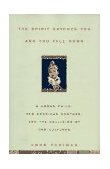Serendip is an independent site partnering with faculty at multiple colleges and universities around the world. Happy exploring!
The Spirit Catches You and You Fall Down: A Hmong Child, Her American Doctors, and the Collision of Two Cultures

|
Serendip's Bookshelves |
 Anne Fadiman, The Spirit Catches You and You Fall Down: A Hmong Child, Her American Doctors, and the Collision of Two Cultures, Farrar, Straus, and Giroux, 1998 Anne Fadiman, The Spirit Catches You and You Fall Down: A Hmong Child, Her American Doctors, and the Collision of Two Cultures, Farrar, Straus, and Giroux, 1998
Commentary by Anne Dalke. Anne is in the Department of English and coordinator of Feminist and Gender Studies at Bryn Mawr College. |
My college roommate Shaye Moore, who is now on the board of the Integrative Medical Alliance, recommended Fadiman's book to me. I'm finding it a rich resource in a variety of arenas explored elsewhere on Serendip:
- the juxtaposition of physical and spiritual explanations of phenomena
- questions about the relationship of neurobiology and behavior
- matters of physical and mental health and
- the acknowledgement of the "diginity of difference."
Excerpted below find a few passages which seemed to me particularly illuminating (additional information and excerpts are here). The setting is a California hospital; Dan is an American doctor, Foua and Nao Kao the parents of a child, and refugees from Laos.)
Dan had no way of knowing that Foua and Nao Kao had already diagnosed their daughter's problem as the illness where the spirit catches you and you fall down. Foua and Nao Kao had no way of knowing that Dan had diagnosed it as epilepsy, the most common of all neurological disorders. Each had accurately noted the same symptoms, but Dan would have been surprised to hear that they were caused by soul loss, and Lia's parents would have been surprised to hear that they were caused by an electrochemical storm inside their daughter's head that had been stirred up by the misfiirng of aberrant brain cells.Dan had learned in medical school that epilepsy is a sporadic malfunction of the brain....During an epileptic episode, instead of following their usual orderly protocol, the damaged cells in the cerbral cortex transmit neural impulses simultaneously and chaotically....
The Hmong are not the only people who might have good reason to feel ambivalent about suppressing the symptoms. The Greeks called epilepsy "the sacred disease." Dan Murphy's diagnosis added Lia Lee to a distinguished line of epileptics that has included Soren Kierkegaard, Vincent van Gogh, Gustave Flaubert, Lewis Carroll, and Fyodor Dostoyevsky, all of whom, like many Hmong shamans, experienced powerful senses of grandeur and spirutal passion during their seizures, and powerful creative urges in their wake. As Dostoyevsky's Prince Myskin asked, "What if it is a disease? What does it matter that it is an abnormal tension, if the result, if the moment of sensation, remembered and analyzed in a state of health, turns out to be harmony and beauty brought to their highest point of perfection, and gives a feeling, undivined and undreamt of till then, of completeness, proportion, reconcilation, and an escstatic and prayerful fusion in the highest synthesis of life?"
Dan['s]...view of medicine in general, and of epilepsy in particular, was, like that of his colleagues...essentially rationalist. Hippocrates' skeptical commentary on the nature of epilepsy, made around 400 B.C., pretty much sums up Dan's own frame of reference: "It seems to me that the disease is no more divine than any other. It has a natural cause just as other diseases have. Men think it is divine merely because they don't understand it. But if they called everything divine which they do not understand, why, there would be no end of divine things." (28-30)


